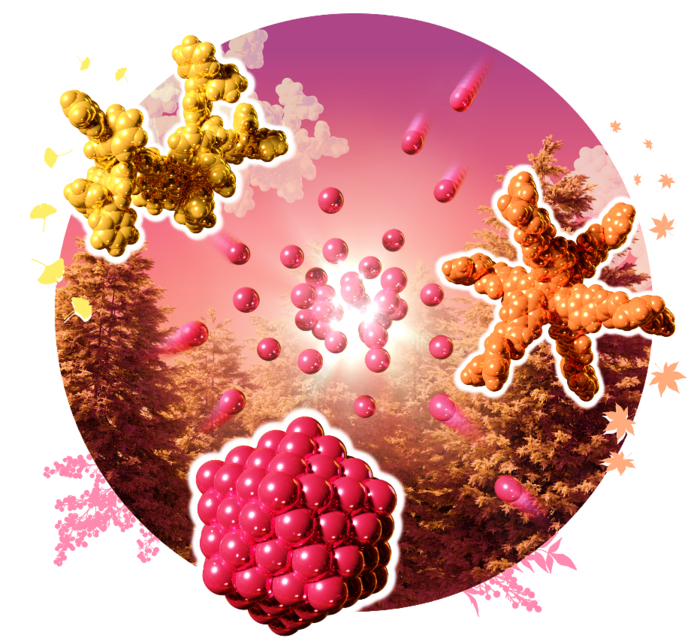Nanoparticles, with sizes ranging from 3–500 nm, and sub-nanoclusters, with approximately 1 nm diameter, are used in several areas, such as robotics, materials science, medicine and engineering. They have unique properties, owing to their tiny size and huge surface-area-to-volume ratios, which make them beneficial in a wide range of applications, from pollution control to chemical synthesis.
 This scientific illustration of the study, created by Dr. Takamasa Tsukamoto of Tokyo Tech, was selected as an inside cover picture in Angewandte Chemie International Edition. Image credit: Dr. Tsukamoto, Tokyo Tech.
This scientific illustration of the study, created by Dr. Takamasa Tsukamoto of Tokyo Tech, was selected as an inside cover picture in Angewandte Chemie International Edition. Image credit: Dr. Tsukamoto, Tokyo Tech.
Lately, quasi-sub-nanomaterials, which are around 1–3 nm in size have gained attention as they tend to have a dual nature, where they can be considered as nanoparticles and inorganic molecules.
Regulating the number of atoms in a quasi-sub-nanomaterial can be of considerable value, understandably. Nevertheless, synthesizing those small molecular structures is technically difficult. However, Tokyo Tech’s researchers were definitely up for the experiment.
Dendrons are extremely branched molecular structures that consist of basic imines. They have been proposed as possible precursors for the accurate synthesis of quasi-sub-nanomaterials with the desired number of atoms.
The imines in the dendrons work as a scaffold that can create complexes with particular acidic metallic salts, gathering metals on the dendron surface. In turn, they can be reduced to metal sub-nanoclusters that come with the desired number of atoms. Yet, synthesizing dendrons with a huge proportion of imines is a costly method that offers low yield.
The scientists elaborate on how they have integrated several dendrimer structures to create a supramolecular capsule that is made of more than 60 imines. This study was published in the journal Angewandte Chemie.
The synthesis of dendron-assembled supramolecules was accomplished by connecting internal core units and external dendron units—which determine the central structure and terminal branches, respectively.
Takamasa Tsukamoto, Assistant Professor, Tokyo Institute of Technology
Prof. Tsukamoto was also involved in this study.
The interior of this supramolecule had a six-pronged core with acidic tritylium, whereas each outer unit had dendrons with imines. A self-assembling organo-complex has resulted in the interaction between the acidic core and the basic outer structure.
Furthermore, the imines were identified to co-accumulate with rhodium salts in such a way that the innermost imines created a complex with tritylium units, whereas the outermost ones were populated with the rhodium salts. The subsequent supramolecule, with an internal core unit bounded by six external dendron units (each with 14 rhodium salts present at the outer imines), was efficiently reduced to clusters with 84 rhodium atoms in a size of 1.5 nm.
For the synthesis of quasi-sub-nanomaterials, the scientists built a supramolecular template by attaching dendron-containing imine to an acidic core. The approach can also be utilized to synthesize different supramolecular structures, as the imines can create complexes with a vast range of cationic units.
Due to its simplicity, versatility and cheap cost, this approach could be a cornerstone for the new nanomaterials’ development.
This novel approach for obtaining atomicity-defined quasi-sub-nanomaterials without the limitations of conventional methods has the potential to play an important role in exploring the last frontiers of nanomaterials.
Takamasa Tsukamoto, Assistant Professor, Tokyo Institute of Technology
This might be a “small” step for Tokyo Tech, but, indeed, a “giant” leap for nanoscience.
Journal Reference:
Tsukamoto. T., et al. Highly Accurate Synthesis of Quasi-sub-nanoparticles by Dendron-assembled Supramolecular Templates. Angewandte Chemie International Edition. doi.org/10.1002/anie.202114353.